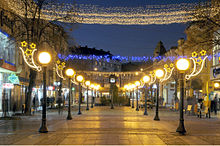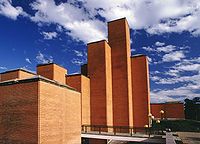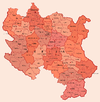- Kragujevac
-
Kragujevac
Крагујевац— City — 
Coat of armsLocation of Kragujevac within Serbia Coordinates: 43°59′N 20°53′E / 43.983°N 20.883°ECoordinates: 43°59′N 20°53′E / 43.983°N 20.883°E Country Serbia District Šumadija Municipalities 5 Founded 1476 Government – Mayor Veroljub Stevanović – Ruling parties Together for Šumadija Area – City 835 km2 (322.4 sq mi) Population (2011)[1][2] – City 147,281 – Urban 177,468 – Urban density 559.10/km2 (215.87/sq mi) Time zone CET (UTC+1) – Summer (DST) CEST (UTC+2) Postal code 34000 Area code(s) (+381) 34 Car plates KG Website www.kragujevac.rs Kragujevac (Serbian Cyrillic: Крагујевац, pronounced [krǎɡujeʋat͡s] (
 listen)) is the fourth largest city in Serbia, the main city of the Šumadija region and the administrative centre of Šumadija District. It is situated on the banks of the Lepenica River. According to official,results of the 2011 census, the city has a population of 147,281 inhabitants, while municipality has a population of 177,468.
listen)) is the fourth largest city in Serbia, the main city of the Šumadija region and the administrative centre of Šumadija District. It is situated on the banks of the Lepenica River. According to official,results of the 2011 census, the city has a population of 147,281 inhabitants, while municipality has a population of 177,468.
Kragujevac was the first capital of modern Serbia (1818–1839), and the first constitution in the Balkans was proclaimed in this city in 1835. Further on, the first full- fledged university in the newly independent Serbia was founded in 1838, preceded by the first grammar school (Gimnazija), Printworks (both in 1833), professional National theatre (1835) and the Military academy (1837).Belgrade took the lead by becoming the seat of the throne in 1841. The University of Kragujevac was not reestablished until 1976. Contemporary Kragujevac is known for its weapons, munition, and Zastava Automobiles company.
Contents
History
Early and medieval
The name of the town derived from the archaic Serbian word "kraguj", which is a name used for a particular species of hawk, thus the name means "hawk's nesting place". Interestingly, old maps show the name as Krakow.
Kragujevac experienced a lot of historical turbulence, not always without severe casualties. Over 200 archaeological sites in Šumadija confirm that the region's first human settlements occurred 40,000 years ago, during the Paleolithic era. Kragujevac was first mentioned in the medieval period as related to the public square built in a settlement, while the first written mention of the city was in the Turkish Tapu-Defter in 1476. Turkish documents from the 15th century refer to it as a "village of Kragujevdza". The town itself gained prominence during the Ottoman period (1459–1804) as the central point in the Belgrade Pashaluk.
Early modern period
The city is located at crossroads. Given this location, the city has been devastated many times and has suffered great losses of life in a number of wars throughout history. It began to prosper after Serbia's liberation from Turkish rule in 1818, when Prince Miloš Obrenović proclaimed it the capital of the new Serbian State and built the Amidža Konak. The first Serbian constitution was proclaimed here in 1835 and the first idea of independent electoral democracy. The first law on the printing press was passed in Kragujevac in 1870. Kragujevac, the capital, was developing and cherishing modern, progressive, free ideas and resembled many European capitals of that time.
Apart from contemporary political influence, Kragujevac became the cultural and educational center of Serbia. Important institutions built during that time include Serbia's first secondary school (Gimnazija), first pharmacy, and first printing press. Kragujevac gave rise to many international scholars, professors, academics, scientists, artists and statesmen.
The turning point in the overall development of Kragujevac was in 1851 when the Cannon Foundry began production, beginning a new era in the city’s economic development. The main industry of the 19th and 20th century was military production. Kragujevac became one of Serbia’s largest exporters in 1886, when the main Belgrade – Niš railway connected through Kragujevac.
New centuries brought new wars. During World War I, Kragujevac again became the capital of Serbia (1914–1915), and the seat of many state institutions - even the Supreme Army Command was housed within the Court House building. During the war, Kragujevac lost 15% of its population.
Interbellum period
The social aspect, especially theater life in Kragujevac between the two wars was very vibrant. First cultural event in the liberated Kragujevac in 1918 was the establishment of the Theater Gundulic that worked only one season and moved to Belgrade,
Following the model of Academic Theater in Belgrade formation in 1924 at the initiative of Kragujevac Scholars Academic Theater was established there, too that supported contemporary ideas, modern approach to stage, live word and repertoire, thus gaining the reputation of a serious art organization. There were many other cultural institutions in the city which began to grow into a large cultural and industrial hub of Central Serbia.
WWII and the Kragujevac massacre
Main article: Kragujevac massacreKragujevac underwent a number of ordeals, the worst probably having been the October massacre during World War II. The Kragujevac massacre was the slaughter of 2,300 to 5,000 civilians—mostly Serbs and Roma— by Nazi soldiers between 19–21 October 1941.[3] Staniša Brkić, curator of The Museum of 21 October, published a book in 2007 where he listed names and personal data of 2,796 victims.[4] The killings went on from October 19 to October 21, 1941, in retaliation for a partisan attack on German soldiers. 50 people were killed if a German soldier was wounded, while 100 were slaughtered if a German soldier was killed. Among the killed was a whole generation of boys taken directly from schools.[citation needed] A monument for the executed pupils is a symbol of the city. This atrocity has inspired a poem called "Krvava Bajka" ("Bloody Fairy Tale") by Desanka Maksimović, a well known Serbian poet from the former Yugoslavia.
Post-war city
In the post-war period, Kragujevac developed more industry. Its main exports were passenger cars, trucks and industrial vehicles, hunting arms, industrial chains, leather, and textiles. The biggest industry, and the city's main employer was Zastava, which employed tens of thousands. The industry suffered under economic sanctions during the Milošević era, and was all but destroyed by the NATO bombing campaign in 1999. Despite a possible deal with the Italian auto manufacturer, Fiat, to reopen the factory, the city currently suffers from widespread unemployment.
Since 1976, Kragujevac has grown as a university centre. The University of Kragujevac includes the Faculties of Medicine, Engineering, Law, Economics, Philology, Arts, Natural Sciences and Mathematics.
Municipalities & settlements
The city of Kragujevac is divided into the following municipalities:
- Settlements
List of settlements in the municipalities of Kragujevac:
- Kragujevac
- Adžine Livade
- Baljkovac
- Beloševac
- Botunje
- Bukorovac
- Velika Sugubina
- Velike Pčelice
- Veliki Šenj
- Vinjište
- Vlakča
- Goločelo
- Gornja Sabanta
- Gornje Grbice
- Gornje Jarušice
- Gornje Komarice
- Grošnica
- Desimirovac
- Divostin
- Dobrača
- Donja Sabanta
- Donje Grbice
- Donje Komarice
- Dragobraća
- Drača
- Drenovac
- Dulene
- Đuriselo
- Erdeč
- Jabučje
- Jovanovac
- Kamenica
- Korman
- Kotraža
- Kutlovo
- Lužnice
- Ljubičevac
- Mala Vrbica
- Mali Šenj
- Maršić
- Masloševo
- Mironić
- Novi Milanovac
- Opornica
- Pajazitovo
- Poskurice
- Prekopeča
- Ramaća
- Resnik
- Rogojevac
- Trešnjevak
- Trmbas
- Ugljarevac
- Cvetojevac
- Cerovac
- Čumić
- Šljivovac
Economy
Kragujevac has been an important industrial and trading centre in Serbia for over two centuries. The city's industry are best known by its automotive production and firearms manufacturing. The former state-owned Zastava Automobiles company was founded in 1953 and produced the well known, Yugo subcompact brand of vehicles. Zastava was sold to Fiat in 2008, with Fiat pledging to invest 700 million euros into the company now renamed as Fiat Automobiles Serbia. Weapons manufacturung in Kragujevac began in 1853 and has since grown to become Serbia's primary supplier of firearms through the Zastava Arms corporation.
Demographics
Ethnic groups in the municipal area of Kragujevac (including all municipalities) as of 2002:
Ethnicity Number Serbs 170,147 Roma 1,154 Yugoslavs 401 Macedonians 326 Croats 204 Muslims 151 Other 3,197 Total 175,577 Politics
Results of the 2008 local elections:[5]
- Together for Šumadija (41)
- For a European Serbia (14)
- Democratic Party of Serbia (6)
- Socialist Party of Serbia (8)
- Serbian Radical Party (18)
Main sights
The architecture of Kragujevac displays a fusion of two different styles—traditional Turkish (nowadays almost completely gone) and 19th century Vienna Secession style. Modern conceptions also appear throughout the city, firstly in the shape of post-war concrete (usually apartments designed to house those left homeless during World War II), and secondly the up-to-date glass offices reflecting the ambitious business aspects of modern architects.
Some important buildings and institutions in Kragujevac include:
- The old church of Descent of the Holy Spirit was built in 1818, as a part of Prince Miloš' court. Its interior was decorated from 1818 to 1822. The new belfry was built in 1907.
- The Old Parliament was built in the court of the church where the first parliamentary meeting was held in 1859. Many events of great historical importance, such as verifying the Berlin Congress decision about the independence of Serbia, took place there. After undergoing reconstruction in 1992, the building was converted into a museum.
- The Amidža Konak was built by Prince Miloš in 1820 as a residential house. It is one of the finest examples of regional architecture in Serbia. It now houses an exhibition from the National Museum.
- The Prince Mihailo Konak was built in 1860. Its architecture blends local tradition with European architectural concepts. The building is now the National Museum.
- The High School (Gimnazija) was built between 1885 and 1887 according to designs from the Ministry of Civil Engineering. It is one of the city's oldest edifices designed in a European style, in the tradition of the oldest Serbian Gimnazija from 1833. Some famous Serbian scientists, artists and politicians were educated in this school.
 Knjaževsko-srpski teatar (Serbian Principal Theatre), 1835
Knjaževsko-srpski teatar (Serbian Principal Theatre), 1835
- These institutions continue to promote cultural activities in modern-day Kragujevac: Knjaževsko-srpski teatar (founded in 1835), National Library "Vuk Karadžić" (1866), Cultural and Artistic Group "Abrasević" (1904).
- The "Kragujevac October" Memorial Park, located in Šumarice, commemorates the tragic events of October 21, 1941.
- The National Museum has various displays including those pertaining to archeology, ethnic diversity, the history of Kragujevac and Šumadija and many paintings. The archeology department has a rich collection of 10,000 display items and over 100,000 study items. The painting department has over 1,000 pieces of prominent Serbian art of extraordinary value.
- The "Zastava Museum" is located within the old gun foundry and exhibits the history of industrial development in Kragujevac and Serbia.
- The Historical Archives of Šumadija collects and files the archives and issues of the seven municipalities of Šumadija and has at its disposal 700 meters of archive issues with 780 registries and hundreds of thousands of original historical documents.
- Tourists may also be interested in the range of scenic attractions nearby, including the Aranđelovac, Vrnjačka Banja, and Mataruška Banja, Karađorđe's castle, the Church of Saint George in Topola 40 km away, the Old Kalenić monastery 55 km away, the resorts of Rogot (28 km) and Stragari (34 km) with old monasteries of Blagoveštenje and Voljavca.
Sports
The city is home to the Bandy Federation of Serbia.[6] The team of Kragujevac plays against the one from Subotica. FK Slavija is the association football team for the city.
Famous residents
- Miloš Obrenović
- Milan Obrenović II
- Mihailo Obrenović III
- Milan Obrenović
- Nikola Pašić
- Radomir Putnik
- Jovan Ristić
- Vuk Stefanović Karadžić
- Joakim Vujić
- Radoje Domanović
- Svetozar Marković
- Dragoslav Srejović
- Mija Aleksić
- Ljuba Tadić
- Draginja Adamović
- Dragan Todorović
- Radomir Mihailović Točak
Twin towns - sister cities
See also: List of twin towns and sister cities in SerbiaKragujevac is twinned with:[7]
 Suresnes, France, since 1967
Suresnes, France, since 1967 Piteşti, Romania, since 1971
Piteşti, Romania, since 1971 Bydgoszcz, Poland, since 1971
Bydgoszcz, Poland, since 1971 Ohrid, Macedonia, since 2001
Ohrid, Macedonia, since 2001 Bielsko-Biała, Poland, since 2002
Bielsko-Biała, Poland, since 2002 Springfield, United States, since 2002
Springfield, United States, since 2002 Reggio Emilia, Italy, since 2004
Reggio Emilia, Italy, since 2004 Mogilev, Belarus, since 2006
Mogilev, Belarus, since 2006
The town has other forms of cooperation and city friendship similar to the twin/sister city programmes with:
 Trenčín, Slovakia
Trenčín, Slovakia Carrara, Italy
Carrara, Italy Bat Yam, Israel, since 1992
Bat Yam, Israel, since 1992 Drama, Greece
Drama, Greece Hanover, Germany
Hanover, Germany Ingolstadt, Germany, since 2003
Ingolstadt, Germany, since 2003 Mostar, Bosnia and Herzegovina
Mostar, Bosnia and Herzegovina Karlovac, Croatia
Karlovac, Croatia Foča, Bosnia and Herzegovina
Foča, Bosnia and Herzegovina Opole, Poland [8]
Opole, Poland [8] Sinchon, South Korea
Sinchon, South Korea
Local media
- Radio stations
- Bravo radio (103.7)link title
- Bis radio (97.9)
- Radio Stari Grad (104.3)
- Radio 9 (95.9)Official Website
- Radio Kragujevac (94.7)
- Radio Zlatousti (90.50)
- Radio 34 (88.9)
- TV stations
- Newspapers
- Svetlost
- Kragujevacke
See also
- List of places in Serbia
- University of Kragujevac
- Faculty of Economics
- Šumarice Memorial Park
- Kragujevac massacre
- Museum of Genocide
- Knjaževsko-srpski teatar
- Joakimfest
- First Kragujevac Gymnasium
- Šumadija fairground
- Gruža Lake
Notes
- ^ Popis stanovništva, domaćinstava i Stanova 2011. Knjiga 1: Nacionalna ili etnička pripadnost po naseljima. Srbija, Republički zavod za statistiku Beograd 2011. ISBN 86-84443-00-09
- ^ "Human resources". Statistics office of Serbia. http://media.popis2011.stat.rs/2011/prvi_rezultati.pdf. Retrieved 2011-11-16.
- ^ "German Occupation of Serbia and the Kragujevac Massacre, by Carl K. Savich". Antiwar.com. http://www.antiwar.com/orig/savich3.html. Retrieved 2011-09-16.
- ^ "Blic Online | Srbija | "Engleska krvava bajka" u Kragujevcu". Blic.co.rs. http://www.blic.co.rs/srbija.php?id=16913. Retrieved 2011-09-16.
- ^ http://www.cesid.org/rezultati/sr_maj_2008-lokalni/xls/Kragujevac_LOKALNI_IZBORI.xls
- ^ "Federation of International Bandy-About-About FIB-National Federations-Serbia-Serbia". http://www.internationalbandy.com/viewNavMenu.do?menuID=67.
- ^ "Kragujevac Twin Citys". © 2009 Information service of Kragujevac City. http://www.kragujevac.rs/Gradovi_prijatelji-59-1. Retrieved 2009-02-21.
- ^ "Opole Official Website - Twin Towns". (in English and Polish) © 2007-2009 Urząd Miasta Opola. http://www.opole.pl/miasto/index.php?option=com_content&task=blogcategory&id=20&Itemid=108. Retrieved 2009-06-18.
Gallery
External links
Historical capitals of Serbia since 1841 BelgradeCategories:- Former capitals of Serbia
- Populated places in Šumadija District
- Kragujevac
- Šumadija
- University towns
- 1476 establishments
Wikimedia Foundation. 2010.
























